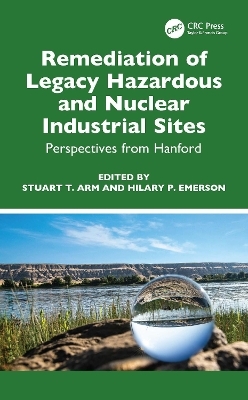
Remediation of Legacy Hazardous and Nuclear Industrial Sites
CRC Press (Verlag)
978-1-032-35672-3 (ISBN)
Remediation of Legacy Hazardous and Nuclear Industrial Sites provides an overview of the key elements involved in remediating complex waste sites using the Hanford nuclear site as a case study. Hanford is one of the most complex waste sites in the world and has examples of most, if not all, characteristics of the complex waste sites that exist globally. This book is aimed at a non-technical audience and describes the stages of remediation based on general RCRA/CERCLA processes, from establishing a strategy that includes all stakeholders to site assessment, waste treatment and disposal, and long-term monitoring.
Features:
Informs a non-technical audience of the important elements involved in complex waste site remediation
Employs the Hanford Site as a case study throughout to explain real-world applications of remediation steps
Connects the “human” element to the technical aspects through interviews with key current and retired individuals at the Hanford Site
Includes discussion of stakeholders and the engagement process in remediation
Demonstrates how all elements of complex waste site remediation from demolition of buildings to groundwater management are interrelated
Focuses on broader technical and sociopolitical challenges for remediation of a contaminated site
Aimed at a broad audience, this book offers approachable guidance to technical and non-technical readers through a series of real-world examples that cover each important step in the complex waste cleanup process.
Dr. Stuart T. Arm is a senior technical advisor who returned to Pacific Northwest National Laboratory (PNNL) in 2019 after 12 years working in industry. Dr. Arm holds a PhD and MEng in chemical engineering from Imperial College, London, and has 30 years’ experience in national laboratories and the nuclear industry in the United Kingdom and the United States. He establishes PNNL and DOE strategic plans and objectives for radiochemical process flowsheets and technologies for treating and managing radioactive waste and commercial used nuclear fuel while acknowledging emerging national and international trends. Dr. Arm employs a collaborative and leading approach to technology and flowsheet maturation and integration to establish implementation strategies with multitechnical and organizational elements. Dr. Hilary P. Emerson’s research focuses on the fate and remediation of radionuclides with experimental testing from the laboratory to the field scale. She holds a BS in Environmental Engineering (2009) from the University of Central Florida and a PhD in Environmental Engineering and Earth Science (2014) from Clemson University. Since joining Pacific Northwest National Laboratory in 2019, her work has focused primarily on the development of new remediation technologies for radionuclides and techniques for monitoring remediation technologies.
PART I Site Assessment and Characterization
Stuart T. Arm and Hilary P. Emerson
Chapter 1 Developing a Remediation Framework
Katherine A. Muller, Courtney L. H. Bottenus, and Christian D. Johnson
Chapter 2 Stakeholder Perspectives and Environmental Remediation
Ellen Prendergast‑Kennedy
PART II Site Assessment and Characterization
Christian D. Johnson, Katherine A. Muller, and Hilary P. Emerson
Chapter 3 Characterization of a Uranium Groundwater Plume along the Columbia River
Amanda R. Lawter and Michelle M.V. Snyder
Chapter 4 Plutonium Finishing Plant Building and Subsurface
Waste Release Characterization
Calvin H. Delegard, Carolyn I. Pearce, Hilary P. Emerson, Andrea M. Hopkins, and Theodore J. Venetz
Chapter 5 Tank Waste Characterization: History, Challenges, and Successes
Emily Campbell, Carolyne Burns, and Richard Daniel
Chapter 6 Waste Tank Structural Assessment
Christopher Grant and Naveen Karri
PART III Remedy Screening, Evaluation, and Testing
Christian D. Johnson, Katherine A. Muller, and Hilary P. Emerson
Chapter 7 Soil Desiccation Treatability Testing at BC Waste Disposal Cribs
Adam R. Mangel and Christopher E. Strickland
Chapter 8 Wasteform Development and Qualification for Tank Waste
Vitrification and Disposal
Jose Marcial and Derek Dixon
Chapter 9 Plutonium Finishing Plant Demolition and Interim Subsurface Disposal Structure Stabilization
Calvin H. Delegard, Carolyn I. Pearce, Hilary P. Emerson, Andrea M. Hopkins, and Theodore J. Venetz
PART IV Remedial Action
Christian D. Johnson, Katherine A. Muller, and Hilary P. Emerson
Chapter 10 Groundwater Remediation with Pump‑and‑Treat Technology
Sarah Saslow and Christian D. Johnson
Chapter 11 Enhanced Attenuation of Uranium in the Subsurface
Amanda R. Lawter and Michelle M.V. Snyder
Chapter 12 Retrieval of Tank Waste from Storage
Matthew Fountain and Beric Wells
Chapter 13 Integrated Waste Treatment Flowsheet and Interface Management Strategy
Jennifer A. Kadinger and Courtney L. H. Bottenus
Chapter 14 Tank Waste Disposal
R. Matthew Asmussen
PART V Long‑Term Stewardship and Future Land Use
Vicky L. Freedman and Nicolas J. Huerta
Chapter 15 End State: Vision for Future Land Use at Hanford
Vicky L. Freedman and Nicolas J. Huerta
Chapter 16 Afterword
Nikolla P. Qafoku
| Erscheinungsdatum | 22.08.2024 |
|---|---|
| Zusatzinfo | 20 Tables, black and white; 6 Line drawings, color; 45 Line drawings, black and white; 11 Halftones, color; 46 Halftones, black and white; 17 Illustrations, color; 91 Illustrations, black and white |
| Verlagsort | London |
| Sprache | englisch |
| Maße | 178 x 254 mm |
| Gewicht | 675 g |
| Themenwelt | Naturwissenschaften ► Chemie ► Technische Chemie |
| Technik ► Bauwesen | |
| Technik ► Elektrotechnik / Energietechnik | |
| Technik ► Maschinenbau | |
| Technik ► Umwelttechnik / Biotechnologie | |
| ISBN-10 | 1-032-35672-3 / 1032356723 |
| ISBN-13 | 978-1-032-35672-3 / 9781032356723 |
| Zustand | Neuware |
| Informationen gemäß Produktsicherheitsverordnung (GPSR) | |
| Haben Sie eine Frage zum Produkt? |
aus dem Bereich


